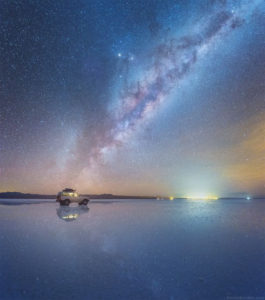“From earth to heaven! High above me was Night’s shadowy bower, traversed, vine-like, by the Milky Way, and heavy with golden clusterings. Oh stars! oh eyes, that see me, wheresoe’er I roam: serene, intent, inscrutable for aye, tell me Sybils, what I am. – Wondrous worlds on worlds! Lo, round and round me, shining, awful spells: all glorious, vivid constellations, God’s diadem ye are! To you, ye stars, man owes his subtlest raptures, thoughts unspeakable, yet full of faith.”
from “Mardi & A Voyage Thither” chapter 58, Melville’s 3rd novel, published in 1849.
 2016: photograph of the Milky Way by Daniel Kordan, Russian astro-photographer, taken at the Salar de Uyuni, Bolivia
2016: photograph of the Milky Way by Daniel Kordan, Russian astro-photographer, taken at the Salar de Uyuni, Bolivia
Gorgeous photos of the Milky Way, reflected in the biggest natural mirror in the world
I first ‘met’ Herman Melville while reading Moby Dick in 2012; my initial time reading this classic text originally published in 1852 that has made miserable many a 20th-century high-school student’s experience of English class, with an inevitable lack of understanding due to lack of life experience: “Why is this considered one of the Great Novels in the language?” Fortunately I was spared that early introduction to Moby; instead I have vague recollections of perusing a copy of a Classics Illustrated version, which I owned as part of a complete set of those publications, which came in handy on occasion for book reports. However Moby’s poorly-drawn cartoon figures put me off, so I never got around to reading all the accompanying conversation balloons to develop an understanding of the story via that medium. I also missed the 1956 movie adaptation directed by John Huston, with Gregory Peck as Captain Ahab. I knew the book only by reputation. So it was serendipitous that in August 2012 while in Alaska visiting my brother Wallace, who happened to have a copy of the book in his library, illustrated by Rockwell Kent, one of my favorite artists, I succumbed to the lore and the lure of Moby. I was hooked from the moment I read those first fateful words: “Call me Ishmael.” which commenced Loomings, the first brilliantly-written chapter that sucked me in, like the whale did Jonah. The book became my reading companion during the two weeks spent in Alaska; remaining unfinished until mid-September after returning home to Philadelphia. I wanted to savor its riches, and did indeed, copying out certain passages on file cards, which I later transcribed to a word file. The immediate aftermath of reading the novel with Rockwell Kent’s powerful b&w illustrations scattered liberally throughout the text was to stimulate me to familiarize myself more deeply with Kent’s work. And what an experience that was! but that’s another story I’ve already touched upon marginally in these postings. See:
Herman Melville, Rockwell Kent, and reading Moby Dick aloud…
It wasn’t until this past winter, when I did a public reading from Moby at The Plastic Club here in town, that I was introduced by Anders Hansen to Melville’s larger oeuvre through a selection of the definitive Northwestern-Newberry editions, six of which he lent me: Typee (pub. 1846), Omoo (1847), Mardi (1849), Redburn (1849), White Jacket (1850) – all published before Moby – and Pierre (1852), the novel immediately after Moby, which basically ended Melville’s career as a novelist. Now thereby hangs a tale! Anyway, last spring I read Melville’s first novel, Typee: A Peep at Polynesian Life published when he was 27-years old, perfect for a first Saturn return. This exotic adventure tale of escape and salvation based on Melville’s youthful experiences in the South Seas was a mesmerizing story, which I read quickly, and which I had also owned in a Classics Illustrated version, in my quest to have a complete set. As with the poorly-illustrated version of Moby I didn’t enjoy the quality of the drawn figures, so I never bothered to read the story. However, reading this fantastically sensuous tale last winter – perfect season to escape to the South Seas – sparked the creation of a series of playfully erotic pencil drawings in February and March. Shortly thereafter I read the Maurice Sendak-illustrated Herschel Parker-edition of Pierre, or the Ambiguities – Melville’s seventh novel that I referred to above – an extraordinary novel of delusion-run-rampant that was way ahead of its time in psychological impact. Back-tracking to novel number two, Omoo: A Narrative of Adventures in the South Seas the reading became a slog; dragging on through the spring, finally reaching the finish line in early July. Pressing on soon thereafter to the third novel Mardi: And a Voyage Thither I have discovered the novel in which Melville the talented and imaginative reporter/travel-writer truly matures into Melville the great romantic poet who uses prose as his medium. I’m a third of the way through…
That still leaves a lot of Melville to read, which I’m looking forward to. Especially recommended by Bob Brault, whom I’ve often quoted in my emails, is The Encantadas or Enchanted Isles from 1854. And let’s not forget Billy Budd left unfinished when Melville died in 1891, published posthumously in 1924. Bon Voyage!
Below, a brief passage from the end of Chapter 1 of Mardi – one of the most lyrically evocative passages I’ve ever read – to wrap up this tribute to one of the greatest writers in the English language, whose work continues to inspire countless individuals to this day. Happy 197th Birthday Herman!
“In the distance what visions were spread! The entire western horizon high piled with gold and crimson clouds; airy arches, domes, and minarets; as if the yellow, Moorish sun were setting behind some vast Alhambra. Vistas seemed leading to worlds beyond. To and fro, and all over the towers of this Ninevah in the sky, flew troops of birds. Watching them long, one crossed my sight, flew through a low arch, and was lost to view. My spirit must have sailed in with it; for directly, as in a trance, came upon me the cadence of mild billows laving a beach of shells, the waving of boughs, and the voices of maidens, and the lulled beatings of my own dissolved heart, all blended together.”



{ 0 comments… add one now }